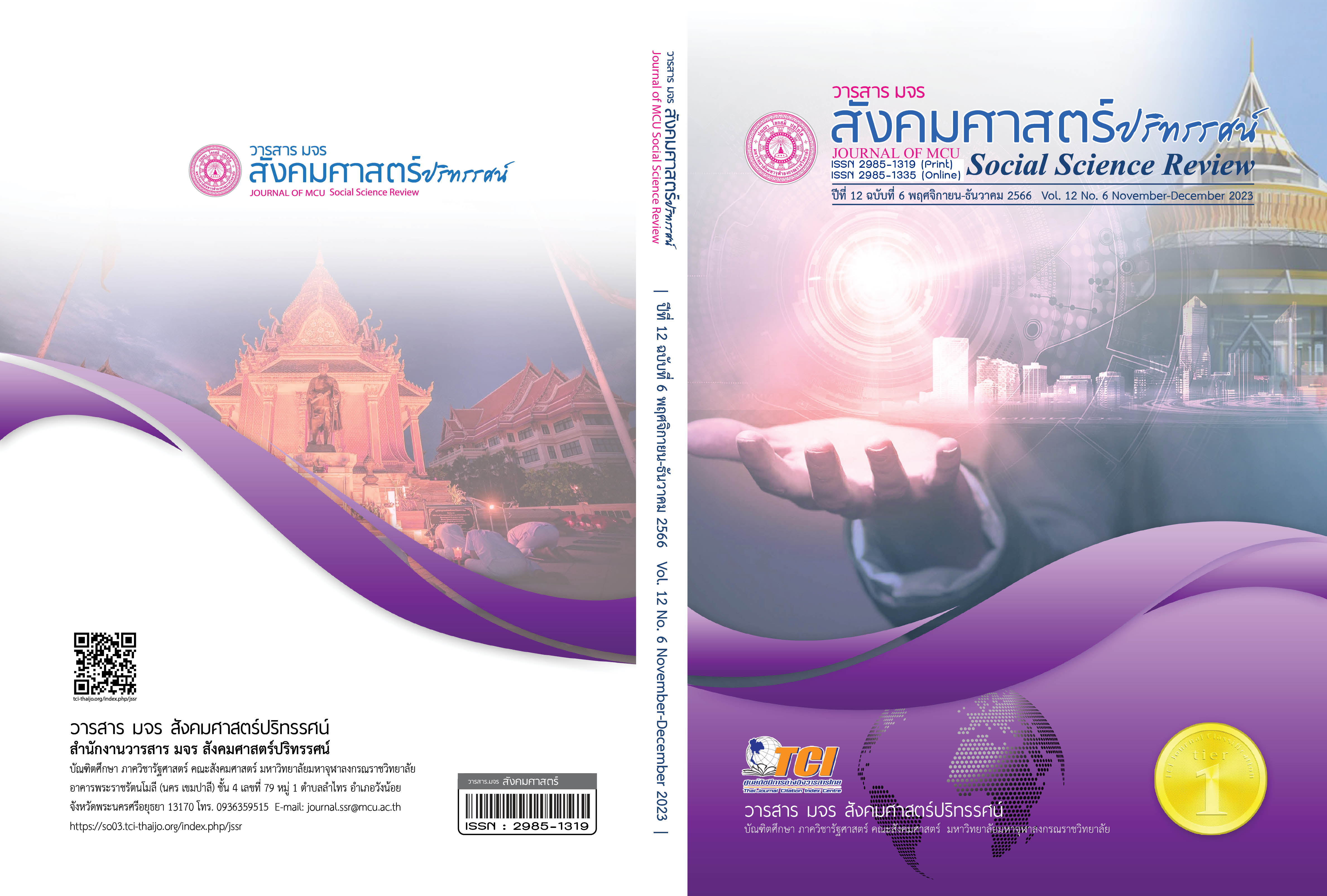การพัฒนาหลักสูตรรายวิชาเพิ่มเติมสตรีในวิถีอาเซียน เพื่อส่งเสริมทักษะ การอยู่ร่วมกันในสังคมพหุวัฒนธรรมสำหรับนักเรียนชั้นมัธยมศึกษาปีที่ 5
คำสำคัญ:
การพัฒนาหลักสูตรรายวิชาเพิ่มเติมสตรีในวิถีอาเซียน, ทักษะการอยู่ร่วมกันในสังคมพหุวัฒนธรรมบทคัดย่อ
บทความวิจัยนี้มีวัตถุประสงค์ 1. พัฒนาหลักสูตรรายวิชาเพิ่มเติมสตรีในวิถีอาเซียน 2. ศึกษาประสิทธิผลของการใช้หลักสูตรรายวิชาเพิ่มเติมสตรีในวิถีอาเซียน ในด้านต่าง ๆ ดังนี้ 2.1 ศึกษาผลการเรียนรู้เรื่องพหุวัฒนธรรมหลังการใช้หลักสูตรรายวิชาเพิ่มเติมสตรีในวิถีอาเซียน 2.2 ศึกษาทักษะการอยู่ร่วมกันในสังคมพหุวัฒนธรรม 2.3 ศึกษาเจตคติในการเป็นพลเมืองทางวัฒนธรรม 2.4 ศึกษาความพึงพอใจของนักเรียนต่อหลักสูตรรายวิชาเพิ่มเติมสตรีในวิถีอาเซียน วิธีดำเนินการวิจัยในลักษณะของการวิจัยและพัฒนา กลุ่มตัวอย่างที่ใช้ในการวิจัย ได้แก่ นักเรียนชั้นมัธยมศึกษาปีที่ 5/2 ภาคเรียนที่ 1 ปีการศึกษา 2564 โรงเรียนราชินีบูรณะ จำนวน 39 คน ใช้แบบแผนการทดลอง The One-Shot Posttest Design เครื่องมือที่ใช้ในการวิจัยประกอบด้วย 1) หลักสูตรรายวิชาเพิ่มเติมสตรีในวิถีอาเซียน 2) แบบทดสอบ 3) แบบประเมินทักษะการอยู่ร่วมกันในสังคมพหุวัฒนธรรม 4) แบบประเมินเจตคติ 5) แบบประเมินความพึงพอใจ สถิติที่ใช้ในการวิเคราะห์ข้อมูล ได้แก่ ค่าร้อยละ ค่าเฉลี่ย ส่วนเบี่ยงเบนมาตรฐาน และวิเคราะห์เชิงเนื้อหา
ผลการวิจัยพบว่า 1. ผลพัฒนาหลักสูตรรายวิชาเพิ่มเติมสตรีในวิถีอาเซียน พบว่า มีองค์ประกอบ ได้แก่ 1) หลักการ 2) จุดประสงค์ 3) แนวทางการจัดการเรียนรู้ และกิจกรรมการเรียนรู้ 4) การวัดและการประเมินผล 5) คำอธิบายรายวิชา 6) ผลการเรียนรู้ 7) โครงสร้างรายวิชา 8) แผนการจัดการเรียนรู้ ผลการประเมินตรวจสอบคุณภาพอยู่ในเกณฑ์คุณภาพระดับมากที่สุด 2. ประสิทธิผลของการใช้หลักสูตรรายวิชาเพิ่มเติมสตรีในวิถีอาเซียน พบว่า 2.1 ผลการศึกษาผลการเรียนรู้ เรื่องพหุวัฒนธรรม อยู่ในเกณฑ์ร้อยละ 85.90 2.2 ผลการศึกษาทักษะการอยู่ร่วมกันในสังคมพหุวัฒนธรรม อยู่ในเกณฑ์ระดับมาก 2.3 ผลการศึกษาเจตคติในความเป็นพลเมืองทางวัฒนธรรม อยู่ในเกณฑ์ระดับมาก 2.4 ผลการศึกษาความพึงพอใจของนักเรียนต่อหลักสูตรรายวิชาเพิ่มเติมสตรีในวิถีอาเซียน อยู่ในเกณฑ์ระดับมากที่สุด
เอกสารอ้างอิง
กระทรวงศึกษาธิการ. (2553). แนวทางการจัดกิจกรรมพัฒนาผู้เรียน : ตามหลักสูตรแกนกลางการศึกษาขั้นพื้นฐานพุทธศักราช 2551 (พิมพ์ครั้งที่ 2). กรุงเทพฯ: โรงพิมพ์ชุมนุม สหกรณ์การเกษตรแห่งประเทศไทย.
ชนสิทธิ์ สิทธ์สูงเนิน. (2564). การพัฒนาหลักสูตร Curriculum Development. นครปฐม: โรงพิมพ์มหาวิทยาลัยศิลปากร.
ณัฐชนา มณีพฤกษ์. (2560). แนวทางการจัดการเรียนการสอนศิลปะที่ส่งเสริมการเห็นคุณค่าในพหุวัฒนธรรม ระดับประถมศึกษาในโรงเรียนนานาชาติ (วิทยานิพนธ์ครุศาสตรมหาบัณฑิต สาขาศิลปศึกษา). กรุงเทพฯ: จุฬาลงกรณ์มหาวิทยาลัย.
ทวิช ลักษณ์สง่า. (2556). การพัฒนาหลักสูตรรายวิชาเพิ่มเติมการศึกษาท้องถิ่น สำหรับนักเรียนชั้นมัธยมศึกษาปีที 4 (วิทยานิพนธ์ศึกษาศาสตรมหาบัณฑิต สาขาหลักสูตรและการนิเทศ). นครปฐม: มหาวิทยาลัยศิลปากร.
ธันยพร บุษปฤกษ์. (2554). การพัฒนาหลักสูตรเสริมสร้างความสามารถในการสร้างสัมพันธภาพระหว่างบุคคลสำหรับนักศึกษาวิศวกรรมศาสตร์ มหาวิทยาลัยเทคโนโลยีราชมงคล (ดุษฎีนิพนธ์ปรัชญาดุษฎีบัณฑิต สาขาหลักสูตรและการสอน). นครปฐม: มหาวิทยาลัยศิลปากร.
ประสพ ลี้เหมือดภัย. (2543). ศิลปนิยม = Art appreciation. กรุงเทพฯ: โอเดียนสโตร์.
พระพรหมคุณาภรณ์ (ป.อ. ปยุตฺโต). (2552). การพัฒนาที่ยั่งยืน = Sustainable development (พิมพ์ครั้งที่ 12). กรุงเทพฯ: มูลนิธิโกมลคีมทอง.
รัตนชนก เมืองเชียงหวาน. (2558). การพัฒนาหลักสูตรรายวิชาเพิ่มเติม วิชาภาษาจีน โดยบูรณาการข้อมูลท้องถิ่นราชบุรี ชั้นประถมศึกษาปีที่ 6 (วิทยานิพนธ์ศึกษาศาสตรมหาบัณฑิต สาขาหลักสูตรและการนิเทศ). นครปฐม: มหาวิทยาลัยศิลปากร.
วิชัย วงษ์ใหญ่ และมารุต พัฒผล. (2554). จากหลักสูตรแกนกลางสู่หลักสูตรสถานศึกษากระบวนทัศน์ใหม่การพัฒนา. กรุงเทพฯ: จรัญสนิทวงศ์ การพิมพ์.
สงัด อุทรานันท์. (2532). พื้นฐานและหลักการพัฒนาหลักสูตร (พิมพ์ครั้งที่ 3). กรุงเทพฯ: โรงพิมพ์มิตรสหาย.
สำนักงานคณะกรรมการการศึกษาขั้นพื้นฐาน. (2562). ประวัติศาสตร์ร่วมรากอุษาคเนย์ : สานเสวนาเพื่อความเข้าใจระหว่างวัฒนธรรมและสันติวัฒนธรรม. กรุงเทพฯ: สำนักงานคณะกรรมการการศึกษาขั้นพื้นฐาน.
องค์การรัฐมนตรีศึกษาแห่งเอเชียตะวันออกเฉียงใต้. (2557). คู่มือหลักสูตรอาเซียน (ASEAN Curriculum Sourcebook). กรุงเทพฯ: โรงพิมพ์ชุมนุมสหกรณ์การเกษตรแห่งประเทศไทย.
Cooper, R. K., & Sawaf, A. (1997). Executive EQ: Emotional Intelligence in Business. London: Orion Business Books.
Goleman. (1998). Working with Emotional. New York: Bantam Books.
Howard, G. (2000). Intelligence Reframed: Multiple Intelligences for the 21st Century. New York: Penguin Putnam.
James, A., et al. (2012). Multicultural Education: Issues and Perspectives (9th ed). United States of America.
Paulo Freire. (1970). Pedagogy of the Oppressed. New York: Herder and Herder.
Saylor, J., et al. (1981). Curriculum planning for better teaching and learning (4th ed). New York: Holt Rinehert and Winston.
Taba. (1962). Curriculum development theory and practice. New York: Harcourt, Brace and Word.
Weisinger, H. (1998). Emotional intelligence at work. San Francisco: Jossy-Bass.
ดาวน์โหลด
เผยแพร่แล้ว
รูปแบบการอ้างอิง
ฉบับ
ประเภทบทความ
สัญญาอนุญาต
ลิขสิทธิ์ (c) 2023 วารสาร มจร สังคมศาสตร์ปริทรรศน์

อนุญาตภายใต้เงื่อนไข Creative Commons Attribution-NonCommercial-NoDerivatives 4.0 International License.
เพื่อให้เป็นไปตามกฎหมายลิขสิทธิ์ ผู้นิพนธ์ทุกท่านต้องลงลายมือชื่อในแบบฟอร์มใบมอบลิขสิทธิ์บทความให้แก่วารสารฯ พร้อมกับบทความต้นฉบับที่ได้แก้ไขครั้งสุดท้าย นอกจากนี้ ผู้นิพนธ์ทุกท่านต้องยืนยันว่าบทความต้นฉบับที่ส่งมาตีพิมพ์นั้น ได้ส่งมาตีพิมพ์เฉพาะในวารสาร มจร สังคมศาสตร์ปริทรรศน์ เพียงแห่งเดียวเท่านั้น หากมีการใช้ภาพหรือตารางหรือเนื้อหาอื่นๆ ของผู้นิพนธ์อื่นที่ปรากฏในสิ่งตีพิมพ์อื่นมาแล้ว ผู้นิพนธ์ต้องขออนุญาตเจ้าของลิขสิทธิ์ก่อน พร้อมทั้งแสดงหนังสือที่ได้รับการยินยอมต่อบรรณาธิการ ก่อนที่บทความจะได้รับการตีพิมพ์ หากไม่เป็นไปตามข้อกำหนดเบื้องต้น ทางวารสารจะถอดบทความของท่านออกโดยไม่มีข้อยกเว้นใดๆ ทั้งสิ้น





